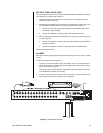
Pelco Manual C1927M (5/99) 5
IMPORTANT SAFEGUARDS AND WARNINGS
Prior to installation and use of this product, the following WARNINGS should be observed.
1. Installation and servicing should only be done by qualified service personnel and
conform to all local codes.
2. Unless the unit is specifically marked as a NEMA Type 3, 3R, 3S, 4, 4X, 6, or 6P
enclosure, it is designed for indoor use only and it must not be installed where
exposed to rain and moisture.
3. Only use replacement parts recommended by Pelco.
4. After replacement/repair of this unit’s electrical components, conduct a resistance
measurement between line and exposed parts to verify the exposed parts have not
been connected to line circuitry.
Please thoroughly familiarize yourself with the information in this manual prior to installation
and operation.
DESCRIPTION
Thank you and congratulations on selecting Pelco’s Genex™ Series multiplexer. You have
chosen to work with the highest quality, most sophisticated yet easy-to-use video multi-
plexer on the market today. Using ActiveImage™ technology, the Genex™ Series multiplex-
ers have exceptionally high resolution digital multiple-screen displays.
With the addition of the KBD4000 remote keyboard and/or the MX4000SVR multiplexer
server, the Genex™ Series offers the greatest degree of system flexibility and expandability
as well.
WHAT IS A VIDEO MULTIPLEXER?
Wherever closed circuit television (CCTV) systems are used, there is often a need to
record and display many different camera views. Whether it is in a small retail environment,
a large casino, or an airport, multiplexers have become the preferred method of collecting
pictures from as many as 16 cameras for recording on a single time-lapse VCR.
In addition, multiplexers allow users to watch up to 16 cameras simultaneously on one
screen, either live or in playback. Should a scene require closer examination, the user can
select full-screen viewing without the loss of detail, as occurs with “quad” devices that
compress four pictures into one for recording.
The multiplexer acts as an interface between the CCTV cameras and the time-lapse VCR.
The multiplexer is designed to switch between cameras much like an ordinary sequential
switcher. Unlike a switcher, however, a multiplexer should switch at exactly the same rate
as the VCR is recording so that just one video picture, or field, is recorded from each
camera before it switches to the next camera. The reason for this is that with a large
number of cameras, you need to switch as fast as you possibly can in order to minimize the
time gap between successive pictures from a given camera.
In most respects, time-lapse VCRs are very similar to the VHS video recorder that you
probably have in your home. The single largest difference is that a time-lapse VCR allows
as much as 960 hours of video to be recorded on a single T-120 (two-hour) VHS cassette.
The total amount of time varies by make and model, but even the lowest cost models allow
for a lot longer recording time than a normal consumer VCR.
When you record a tape on your home VCR and play the tape, you see normal motion, just
as you do on your television. If you connect one camera to a multiplexer and record the
video at the two-hour speed on a time-lapse recorder, motion will appear normal when you
play the tape, just like on your home VCR. But as you add more cameras to the multiplexer,
the multiplexer has to switch between cameras and there is a gap in the video pictures
recorded for any one camera. The more cameras there are, the longer the gap is because
it takes longer for the multiplexer to switch between all the cameras. When the tape is
played, the motion becomes jerky because of the missing video.


















